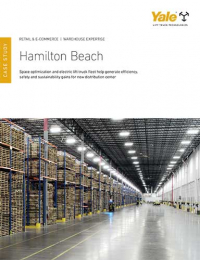Lift Trucks join the connected enterprise
Manufacturers, dealers and users of lift trucks are jointly navigating a brave new world of lift truck integration with broader systems and processes.
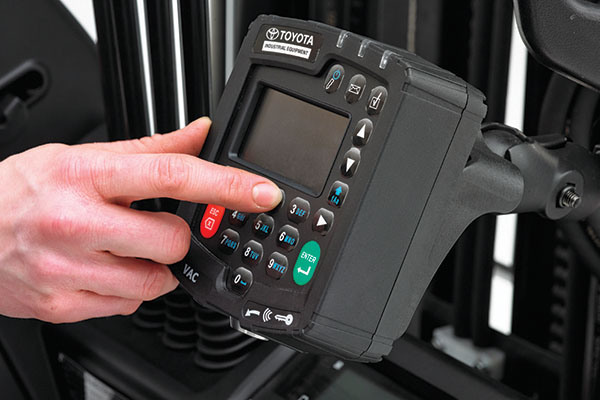
Modern warehouses, distribution centers and supply chains as a whole are all about connections: connected processes, connected workers, connected equipment, connected service and support. As the new currency of improvement, data is essential to identifying and building those connections. The modern lift truck, whether equipped with standard data ports or more sophisticated telematics systems, is joining the connected enterprise.
According to Jeremy Sassatelli, telematics sales and operations manager for Toyota Material Handling USA, adoption of telematics has doubled in the last three years. Many fleets large and small have seen the value in collecting and acting upon fleet data to ensure uptime, right-size fleets, control maintenance costs, establish operator accountability, and improve safety. Many others, however, have stuck with the status quo and are likely spending much more than necessary on their fleets.
Sassatelli says the laggards fall into two categories. The first is made up of those companies that simply lack visibility and coordination between fragmented departments.
“Procurement isn’t coordinating with materials handling, and there are lots of gaps in those discussions. That’s a big hole companies could fill if they started using forklift data collection technology,” Sassatelli says. “Then, it’s not a matter of going to another office to have a meeting, because the data is there immediately and answers a lot of questions. The second category is: ‘If it isn’t broken, don’t fix it.’ We see it all the time.”
The problem is that without visibility and a thorough understanding of the total cost of ownership (TCO), there is no way to know how old maintenance habits are undermining fleet effectiveness.
“Those are the customers who need to be led. We can’t sit back and watch them fail,” Sassatelli says. “Forklift manufacturers and dealers have the keys to help customers get at least a little better at what they do. The fusion of data and service is a powerful tool for improving uptime if both parties use that data properly.”
Tapping into the data stream
The first step to using the data properly is acquiring the right data. And, there are mountains of it. John Rosenberger, director of iWarehouse Gateway and global telematics for The Raymond Corp., says OEMs, dealers, end-users and third parties have gotten much better in recent years at turning the fire hose of data into a manageable fountain.
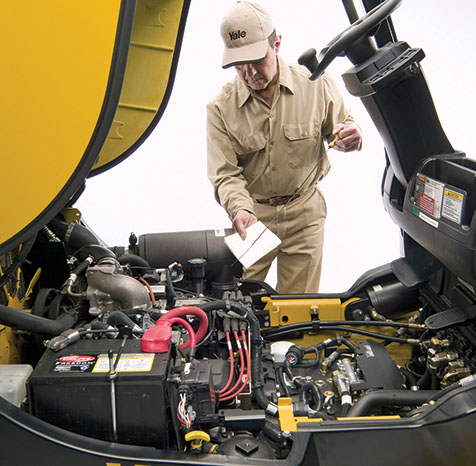 “But, it’s a broad fountain. They don’t just want utilization data, they want to know where it has traveled, some environmental considerations, temperature changes, the list goes on,” Rosenberger says. “We see more organizations like system integrators putting together apps with Raymond to take in that data as part of powered industrial equipment service and setup.”
“But, it’s a broad fountain. They don’t just want utilization data, they want to know where it has traveled, some environmental considerations, temperature changes, the list goes on,” Rosenberger says. “We see more organizations like system integrators putting together apps with Raymond to take in that data as part of powered industrial equipment service and setup.”
It’s becoming more strategic, he adds, with companies considering what data they should use to improve the efficiency of products and systems. In many cases, telematics and a nuanced integration of the forklift into broader processes have moved from “nice to have” to a requirement, Rosenberger says. The goal is to keep costs down and make sure uptime is as close to 100% as possible.
It’s important to note that even a hoard of spare parts and a speedy in-house response to part failures is not a great way to maximize uptime. Grant Tipton, senior manager of technical services for UniCarriers Americas, says fleet data can prove it.
“The dealer has the information in their pocket. In the 1990s, preventive maintenance techs were the youngest, greenest people in the shop, changing filters and oil,” Tipton says. “Now, these technicians have a tablet and conduct a 100-point checklist. They’re looking at everything with the data to back it up. If an alert pops up that the brakes are getting old, the technician can inspect them extra closely.”
The technician can then tell the customer, in detail, the cost to repair versus the cost if the part fails later. It’s a valuable connection between costs and operational impacts, but each customer will approach the data and potential actions differently.
“Think about when you go in for car maintenance, and they say some additional work is needed,” Tipton says. “Ninety percent of the time we say we’ll wait. As much as we love the idea of predictive analytics, so much of it comes back to value selling.”
Many customers buy and maintain lift trucks through the warranty period, and then discipline falls off. On the other hand, many customers with an over-the-road truck fleet are bringing the same mentality to forklifts.
“The National Transportation Safety Board forces compliance on the road,” Tipton says, “but companies soon found they spend less money when they don’t have to send a wrecker to Iowa. It’s the same if you don’t have to send a lift truck technician to Florida.”
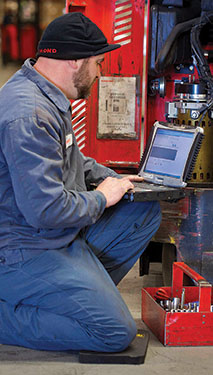
used to take multiple trips to a facility.
Gradually, Tipton says, the industry is shifting from viewing lift trucks as a commodity to seeing them as a capital expenditure that requires ongoing investment to achieve optimal results.
“To build a house, is all I need wood and nails? What about insurance, permits, utilities?” Tipton asks. “To get the most out of your initial investment you need to invest more into it to reach the end game. It’s not a wrench or an air compressor. When it’s down, your business is down.”
When planned maintenance isn’t well planned
One of the key benefits of fleet data is the ability to adjust planned maintenance (PM) schedules from calendar-based to utilization-based, which is typically done every 500 hours. Arbitrary three-month PM intervals almost certainly result in over- or under-maintaining. A lift truck used for 100 hours gets the same service as one with 600.
Telematics can facilitate just-in-time PMs, minimizing touches and downtime by automatically sending alerts to a dealer or in-house maintenance department. Kevin Paramore, sales and marketing manager for motive power and telematics at Yale Materials Handling Corp., calls this “a foolproof way of staying engaged.”
Still, Paramore cautions, PMs based on hours can be challenging because customers hesitate to pay for the travel and labor for a technician to service a single truck. Instead, it’s possible to group PMs to leverage the technician’s visit and make it as cost-effective as possible. For more critical repairs, a technician sitting in a service van can receive a diagnostic trouble code indicating truck 12 needs immediate service. The “connected technician,” Paramore says, can verify he or she has the part to ensure service completion in one visit. Without telematics, the process can be significantly less convenient.
“Laggards still use technicians with notepads and pencils. They make notes and write serial numbers for the next visit or visits,” Paramore says. “That notepad would stay in the van until the technician is back at the office once a week, at which time they research parts, build quotes and take it back for a signature—before the eventual repair visit.”
On the other hand, Paramore says a connected technician using a tablet and either cellular service or Wi-Fi can research parts needed, build a work order, get a customer signature, order the part and schedule the next visit in minutes.
The transition to targeted, timely, per-unit PMs is prohibitively complicated without the right technology. But with what Rosenberger calls “connected maintenance,” it’s possible to examine maintenance costs as they are and as they could be. This can also help avoid well-meaning initiatives that turn out to be a drain on productivity and the bottom line.
“You really have to be careful when you sub-optimize a certain process. If I make a change to reduce costs but then put a burden on the operator, or on process flow, or on equipment, you’ve defeated the purpose,” Rosenberger says. “A secondary checklist, for example, takes just two minutes. But across all operators throughout a year, that’s lots of money. Now you can see the impact of those decisions through the data.”
One step at a time
Paper checklists are still the norm in many facilities, Paramore says, but a mobile app and telematics platform creates a much richer picture to solve problems faster. Consider a facility with 80 trucks. How do they know 80 is the right number?
“Any customer I ask how often their trucks are used, the common response: 24/7, flat out,” Paramore says. “They implement telematics and find that’s not the case. Do you need all 80, all year? Maybe you could rent for the fourth quarter and have a lower fleet count for the rest of the year.”
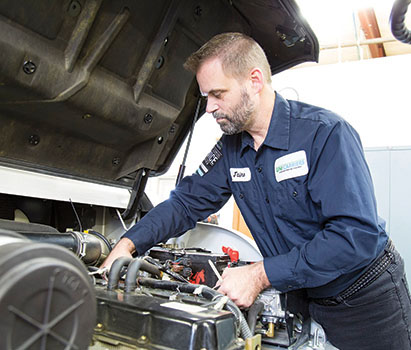
After the early adoption phase of gathering information, the next phase is executing on those insights: Right-size the fleet, drive down maintenance costs, streamline OSHA checklists and corrective actions. The next phase, Paramore says, is still developing within the industry and has to do with broad integration with warehouse management systems (WMS), labor management systems (LMS), enterprise resource planning (ERP), or some third-party solution.
“The industry and its customers are working to accelerate data processing, so they’re looking at the entire connected warehouse,” Paramore says.
Toyota’s Sassatelli agrees that as connected devices become the norm, materials handling equipment needs to be part of that connected environment.
“We’re envisioning a time when machine-to-machine communication integrates these hunks of metal into the software world,” Sassatelli says. “There’s a desire for data from sources that could never supply it before. The problem with a lot of OEMs and suppliers is our infrastructure was never set up to keep pace with that demand for data, pulling it together from the fleet, ERP, WMS, LMS. We’re all working on how to manage that internally to provide even more value.”
Change is tough, Rosenberger adds, but it doesn’t need to happen all at once.
“If you try to change it outright, you won’t get anywhere,” Rosenberger says. “Take it in small chunks. Try one small thing, as a demo, and have a local dealer manage it for you. With a software-as-a-service model (SaaS), you can turn a feature on, see the benefits and then decide. Nobody has to hold this $50,000 bag and hope. If you’re not convinced, fine. Turn it off and move on.”
SaaS and the Cloud mean a fleet of five can use the same processing power that manages a fleet of 2,000. In fact, no fleet is too small to take advantage of telematics, Paramore says. At a previous employer, he recalls 400 employees with access to just one lift truck.
“The DC across town had 50, but that one single lift truck at the corporate office presented the most risk. Only two people were certified to operate it, but there were many more people using it,” Paramore says. “For a one-truck application, they’re not going to look at right-sizing the fleet. They’re looking at operational gains for access control, accountability, impact detection and safety.”
Whatever the fleet size, Paramore says movement in the right direction starts with stopping, observing and benchmarking where things stand today. “Then continue to monitor benchmarks, and lean on service providers for best practices,” he adds. “Never settle.”

Article Topics
Magazine Archive News & Resources
Latest in Materials Handling
Lucas Watson appointed CSO for Körber’s Parcel Logistics business in North America Hyster recognizes Dealers of Distinction for 2023 Carolina Handling names Joe Perkins as COO C-suite Interview with Keith Moore, CEO, AutoScheduler.AI: MODEX was a meeting place for innovation Walmart deploying autonomous lift trucks at four of its high-tech DCs Coles shops big for automation Kathleen Phelps to join FORTNA as chief financial officer More Materials HandlingAbout the Author
Subscribe to Materials Handling Magazine

Find out what the world's most innovative companies are doing to improve productivity in their plants and distribution centers.
Start your FREE subscription today.
April 2024 Modern Materials Handling

Latest Resources
